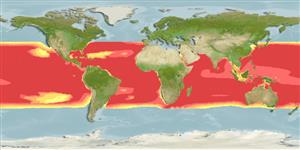>
Aulopiformes (Grinners) >
Omosudidae (Hammerjaws)
Etymology: Omosudis: Greek, omo = shoulder + Latin, sudis = esox, fish of the Rhine, cited by Plinius 9.15; it also means "stake" (Ref. 45335).
Eponymy: Rev. Richard Thomas Lowe (1802–1874) was a British botanist, ichthyologist and malacologist as well as being a clergyman. He graduated from Christ’s College, Cambridge (1825) and then took holy orders. He became a pastor in Madeira (1832), [...] (Ref. 128868), visit book page.
More on author: Günther.
Environment: milieu / climate zone / depth range / distribution range
Ecologia
marinhas batipelágico; intervalo de profundidade 0 - 4000 m (Ref. 38732), usually 100 - 1000 m (Ref. 7344). Deep-water; 40°N - 40°S
Worldwide in tropical and temperate waters. South China Sea and East China Sea (Ref.74511)
Tamanho / Peso / Idade
Maturity: Lm ? range ? - ? cm
Max length : 23.0 cm SL macho/indeterminado; (Ref. 4475); common length : 20.0 cm NG macho/indeterminado; (Ref. 5755)
Descrição suscinta
Chaves de identificação | Morfologia | Morfometria
Espinhos dorsais (total) : 0; Raios dorsais (total) : 9 - 12; Espinhos anais: 0; Raios anais : 14 - 16. Brownish above, sides silvery, iridescent, with black peritoneum showing through (Ref. 7344).
Meso- and bathypelagic at 700-1830 m (Ref. 58302). Probably swift swimmers, which can avoid nets, captured singly or in small groups (Ref. 6692). Carnivorous, feed on squids and pelagic fishes (Ref. 6692). Oviparous and are synchronous hermaphrodites (Ref. 84733).
Ciclo de vida ou comportamento de acasalamento
Maturidade | Reprodução | Desova | Ovos | Fecundidade | Larvas
Are synchronous hermaphrodites, gonads consist of clearly defined and well separated ovarian and testicular regions with no indication of sequential maturation of the sex products (Ref. 84733). Also Ref. 103751.
Post, A., 1984. Omosudidae. p. 496-497. In P.J.P. Whitehead, M.-L. Bauchot, J.-C. Hureau, J. Nielsen and E. Tortonese (eds.) Fishes of the north-eastern Atlantic and the Mediterranean. UNESCO, Paris. Vol. 1. (Ref. 6692)
Status na Lista Vermelha da UICN (Ref. 130435: Version 2024-1)
Ameaça para os humanos
Harmless
Uso pelos humanos
Pescarias: sem interesse
Ferramentas
Relatórios especiais
Baixar XML
Fontes da internet
Estimates based on models
Preferred temperature (Ref.
123201): 4.8 - 21.3, mean 10.5 °C (based on 2379 cells).
Índice de diversidade filogenética (Ref.
82804): PD
50 = 1.5000 [Uniqueness, from 0.5 = low to 2.0 = high].
Bayesian length-weight: a=0.00389 (0.00180 - 0.00842), b=3.12 (2.94 - 3.30), in cm total length, based on all LWR estimates for this body shape (Ref.
93245).
Nível Trófico (Ref.
69278): 4.3 ±0.64 se; based on food items.
Resiliência (Ref.
120179): médio(a), tempo mínimo de duplicação da população 1,4 - 4,4 anos (Assuming tm=2-4).
Fishing Vulnerability (Ref.
59153): Low vulnerability (18 of 100).
